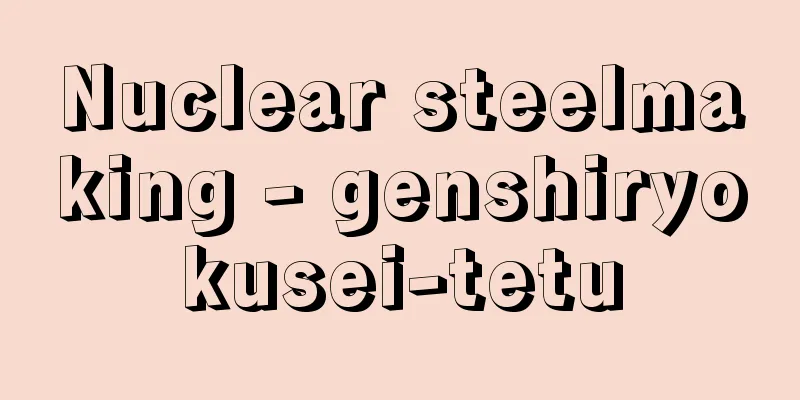Nuclear steelmaking - genshiryokusei-tetu

|
A steelmaking method in which iron ore is directly reduced with high-temperature reducing gas using heat (nuclear heat) obtained from a nuclear reactor. It was first proposed in 1965 by Hermann Schenck (1990-1991) of Aachen University of Technology in the former West Germany. The Iron and Steel Institute of Japan established a Nuclear Energy Subcommittee in 1968 (Showa 43) to conduct research and studies, and in response, the Ministry of International Trade and Industry (MITI) carried out research and development on the basic elemental technologies of nuclear steelmaking as a national project from 1973 to 1980. The general form of introducing nuclear energy into the steelmaking process is shown in below. However, electric steelmaking cannot compete with the blast furnace method unless the unit price of electricity is significantly cheaper, and the method of injecting reducing gas into the blast furnace is not a good idea, so in the end, the method shown by the thick line in is the subject of research and development for the nuclear steelmaking process. Since it is desirable for the process heat for steelmaking to be as high as possible, a high-temperature gas-cooled reactor capable of producing heat of over 1000°C must be developed for nuclear steelmaking reactors. For this reason, the Japan Atomic Energy Research Institute (now the Japan Atomic Energy Agency) has been developing a high-temperature gas-cooled reactor using coated particle fuel and helium gas cooling to produce heat of 950°C, and in April 2004, it achieved the world's first reactor outlet coolant temperature of 950°C. In March 2010, it succeeded in high-temperature continuous operation for 50 days. For reducing gas production, steam reforming of natural gas was considered in European countries, while in Japan, steam cracking and steam reforming of crude oil vacuum distillation residue in a shaft furnace was considered. When utilizing nuclear heat from a high-temperature gas reactor, it is desirable to install a heat exchanger for safety reasons, but its manufacture requires the development of special heat-resistant alloys and ingenuity in structural design, making it an important technological development issue for utilizing high-temperature nuclear heat. [Atsunosuke Nakajima] [Reference item] | |©Shogakukan "> Nuclear steelmaking process (diagram) Source: Shogakukan Encyclopedia Nipponica About Encyclopedia Nipponica Information | Legend |
|
原子炉から得られる熱(核熱)を利用した高温の還元ガスで鉄鉱石を直接還元する製鉄方式。1965年旧西ドイツ、アーヘン工科大学のシェンクHermann Schenck(1990―1991)の提唱に始まる。日本鉄鋼協会は1968年(昭和43)から原子力部会を設けて調査研究を行い、これを受けて当時の通産省は、1973年から1980年にかけて、原子力製鉄の基礎的な要素技術に関する研究開発を、ナショナル・プロジェクトとして進めた。 原子力エネルギーの製鉄プロセスへの導入形態を一般的に示せば、のようになる。しかし電気製鉄は電力単価が格段に低廉でなければ高炉法に対抗できず、また還元ガスを高炉へ吹き込む方式も得策でなく、結局、中太線で示した方式が原子力製鉄プロセスとして研究開発の対象となっている。 製鉄用プロセスヒートとしては、できうる限り高温であることが望ましいので、原子力製鉄用原子炉としては1000℃以上の熱を取り出せる高温ガス炉を開発しなければならない。このため日本原子力研究所(現、日本原子力研究開発機構)で被覆粒子燃料を用い、ヘリウムガス冷却方式で950℃の熱を取り出せる高温ガス炉の開発が進められ、2004年(平成16)4月に世界で初めて原子炉出口冷却材温度950℃を達成した。2010年3月には、50日間の高温連続運転に成功している。還元ガス製造には、ヨーロッパ諸国では天然ガスの水蒸気改質法が、日本では原油の減圧蒸留残渣(ざんさ)油の水蒸気分解‐水蒸気改質をシャフト炉で行う方式が検討された。 高温ガス炉からの核熱を利用する場合、安全上からも熱交換器を置くことが望ましいが、その製作には特殊な耐熱合金の開発と構造設計面でのくふうが必要で、高温の核熱利用のための重要技術開発課題となっている。 [中島篤之助] [参照項目] | |©Shogakukan"> 原子力製鉄のプロセス〔図〕 出典 小学館 日本大百科全書(ニッポニカ)日本大百科全書(ニッポニカ)について 情報 | 凡例 |
<<: Nuclear ship - Genshiryokusen
>>: Three principles of nuclear energy
Recommend
Sandfeld, K.
...In terms of spiritual life, in addition to the...
Eusebius Sophronius Hieronymus
Latin Church Father, Bible scholar, and saint. Hi...
Fleischer, M.
…American animation brothers who brought popular ...
Kahanamoku, D. (English spelling) KahanamokuD
...After that, it was banned as immoral by missio...
Independence Hall
…It was developed mainly by Quakers, and in the c...
Glandular disease - glandular disease
This term has long been used in the past to descr...
palsa
...Slopes are distributed with solifluction lobes...
Gutta-percha
…a thermoplastic rubber-like substance also known...
Schelling, Friedrich Wilhelm Joseph von
Born January 27, 1775 in Leonberg, Württemberg Die...
Salt Monopoly System
The feudal domain monopoly on salt began as a syst...
Egota River
...The main stream of the Kanda River originates ...
Oginkogin - Oginkogin
…It is also called the “Hakone Gongen Engi” and t...
Laws on foreign capital - Laws on insulators
Law No. 163 of 1950. It is also known as the Forei...
Elder statesman - Genro
A general term for certain politicians who were i...
Kawaji [Hot Spring] - Kawaji
This hot spring wells up at the confluence of the ...









